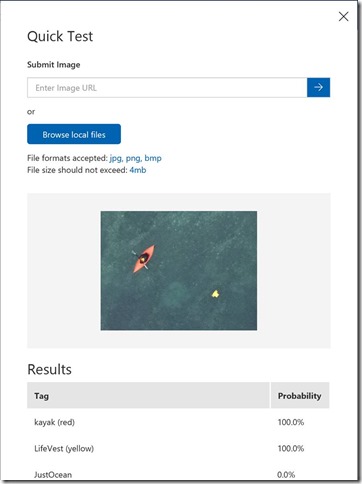Archive for April 2019
Containers – The secret to shipping cloud workloads (Slide deck)
Simple Machine Learning classification with ML.NET (custom code without Model Builder)
TL;DR; check my GitHub project for bank transaction classification. https://github.com/jernejk/MLSample.SimpleTransactionTagging
UPDATE: If you are looking to learn Machine Learning with minimum code and effort, check out Simplified Machine Learning for Developers with ML.NET. The post below was created before ML.NET Model Builder was released and I made a video about it.
Goal
For a long time, I was trying to get into practical machine learning but I found machine learning wasn’t very accessible for most of the devs.
Recently as a challenge, I tried to make a lightning talk, where I tried to explain how to solve a relatable yet usable everyday problem with machine learning in just 15-20 minutes.
For the demo, I have decided to do bank transaction category classification, as this is something I do every week. While I use a financing service Toshl that collects and classifies all of my bank transactions, I still had to spend ~1 hour every week to fix misclassified transactions. I wanted to fix this problem without needing to write a complicated rule engine and machine learning seemed to be the right approach.
For this example, we’ll use .NET Core with ML.NET and a couple of transactions. You can look at https://github.com/dotnet/machinelearning-samples/. We’ll use Multi-class classification, which is perfect for our problem.
My data is coming from the finance app Toshl which already has the correct category labels for each transaction.
Code
First, I started by looking GitHub Issue Labeler and simply modifying its training data to be my transactions. That surprisingly worked pretty well and I have started a new project that was based on that prototype.
After that, I have decided with the following structure for input which was loaded from JSON. Description and transaction type are used as inputs (features) and category as expected result (label).
[DataContract]
public class TransactionData
{
[DataMember(Name = “desc”)]
public string Description { get; set; }
[DataMember(Name = “category”)]
public string Category { get; set; }
[DataMember(Name = “transactionType”)]
public string TransactionType { get; set; }
}
Next data structure is the prediction model. Column name needs to PredictedLabel, while property name can be anything you like.
public class TransactionPrediction
{
[ColumnName(“PredictedLabel”)]
public string Category;
}
I have loaded the data from JSON.Next step is to train a model and save it.This step doesn’t have verification of the model, which is highly recommended but not necessary for ML. (it’s like an integration test for very fragile code)
public class BankTransactionTrainingService
{
public void Train(IEnumerable trainingData, string modelSavePath)
{
var mlContext = new MLContext(seed: 0);
// Configure ML pipeline
var pipeline = LoadDataProcessPipeline(mlContext);
var trainingPipeline = GetTrainingPipeline(mlContext, pipeline);
var trainingDataView = mlContext.Data.LoadFromEnumerable(trainingData);
// Generate training model.
var trainingModel = trainingPipeline.Fit(trainingDataView);
// Save training model to disk.
mlContext.Model.Save(trainingModel, trainingDataView.Schema, modelSavePath);
}
private IEstimator LoadDataProcessPipeline(MLContext mlContext)
{
// Configure data pipeline based on the features in TransactionData.
// Description and TransactionType are the inputs and Category is the expected result.
var dataProcessPipeline = mlContext
.Transforms.Conversion.MapValueToKey(inputColumnName: nameof(TransactionData.Category), outputColumnName: “Label”)
.Append(mlContext.Transforms.Text.FeaturizeText(inputColumnName: nameof(TransactionData.Description), outputColumnName: “TitleFeaturized”))
.Append(mlContext.Transforms.Text.FeaturizeText(inputColumnName: nameof(TransactionData.TransactionType), outputColumnName: “DescriptionFeaturized”))
// Merge two features into a single feature.
.Append(mlContext.Transforms.Concatenate(“Features”, “TitleFeaturized”, “DescriptionFeaturized”))
.AppendCacheCheckpoint(mlContext);
return dataProcessPipeline;
}
private IEstimator GetTrainingPipeline(MLContext mlContext, IEstimator pipeline)
{
// Use the multi-class SDCA algorithm to predict the label using features.
// For StochasticDualCoordinateAscent the KeyToValue needs to be PredictedLabel.
return pipeline
.Append(GetScadaTrainer(mlContext))
.Append(mlContext.Transforms.Conversion.MapKeyToValue(“PredictedLabel”));
}
private IEstimator GetScadaTrainer(MLContext mlContext)
{
return mlContext.MulticlassClassification.Trainers.SdcaMaximumEntropy(“Label”, “Features”);
}
}
The code below will load the model and predict the category.
public class BankTransactionLabelService
{
private readonly MLContext _mlContext;
private PredictionEngine _predEngine;
public BankTransactionLabelService()
{
_mlContext = new MLContext(seed: 0);
}
public void LoadModel(string modelPath)
{
ITransformer loadedModel;
using (var stream = new FileStream(modelPath, FileMode.Open, FileAccess.Read, FileShare.Read))
loadedModel = _mlContext.Model.Load(stream, out var modelInputSchema);
_predEngine = _mlContext.Model.CreatePredictionEngine(loadedModel);
}
public string PredictCategory(TransactionData transaction)
{
var prediction = new TransactionPrediction();
_predEngine.Predict(transaction, ref prediction);
return prediction?.Category;
}
}
And that’s all from machine learning!
Let’s see how everything comes together.
public static void Main(string[] args)
{
// Some manually chosen transactions with some modifications.
Console.WriteLine(“Loading training data…”);
var trainingData = JsonConvert.DeserializeObject(File.ReadAllText(“training.json”));
Console.WriteLine(“Training the model…”);
var trainingService = new BankTransactionTrainingService();
trainingService.Train(trainingData, “Model.zip”);
Console.WriteLine(“Prepare transaction labeler…”);
var labelService = new BankTransactionLabelService();
labelService.LoadModel(“Model.zip”);
Console.WriteLine(“Predict some transactions based on their description and type…”);
// Should be “coffee & tea”.
MakePrediction(labelService, “AMERICAN CONCEPTS PT BRISBANE”, “expense”);
// The number in the transaction is always random but it will work despite that. Result: rent
MakePrediction(labelService, “ANZ M-BANKING PAYMENT TRANSFER 513542 TO SPIRE REALITY”, “expense”);
// In fact, searching just for part of the transaction will give us the same result.
MakePrediction(labelService, “SPIRE REALITY”, “expense”);
// If we change the transaction type, we’ll get a reimbursement instead.
MakePrediction(labelService, “SPIRE REALITY”, “income”);
}
private static void MakePrediction(BankTransactionLabelService labelService, string description, string transactionType)
{
string prediction = labelService.PredictCategory(new TransactionData
{
Description = description,
TransactionType = transactionType
});
Console.WriteLine($”{description} ({transactionType}) = > {prediction}”);
}
In the above example, we tried to identify a coffee shop, rent in 2 different ways and a reimbursement coming from the same description as rent. With machine learning, we can now predict category even if it’s not completely correct, almost like a fuzzy search.
Conclusion
In conclusion, it took me 2 hours to write my initial prototype and about 4 hours to clean up incorrect data. (I’m working with 1k+ real transactions) The results are very good with about 95% accuracy!
With ML.NET most of the work is in selecting the right machine learning configuration and preparing test data. For example, description and transaction type are great features for predicting labels. In contrast, adding features like amount, date/time which more often than not is not directly linked to the label, may result in predictions to be way off or unable anything at all.
In the past, I have made a few attempts to classify my transactions via a rule engine and failed to deliver great long term value with few days of work. The project was abandoned because the projected effort of maintaining the rules was too great.
AI on Drones – Case Study Overview
It is a great time to be a technologist. I am spending lots of my time at the moment thinking about drones, AI & IOT, about where these technologies intersect, and where they can help people.I was very happy when I got asked today to do a quick 10 minute presentation on ‘Where are we at with drones’.
Rather than just deliver it once I thought I’d capture some thoughts here.
eSmart Systems – Using drones for power line inspection
Maintenance of electrical grids is not only time consuming and costly, but it can also be very dangerous. By developing a connected drone that uses AI and cognitive services from Microsoft Azure, utility companies can reduce blackouts and inspect power lines more safely.
[embedded content]
Microsoft FarmBeats -Uses drones, AI and IOT Edge to increase farm productivity
Microsoft FarmBeats aims to enable farmers to increase farm productivity and reduce costs by enabling data-driven farming.
A new partnership between Microsoft and leading drone maker DJI builds on the work both companies are doing with data and agriculture that could make it easier and more affordable for farmers to quickly get the information they need to make crucial decisions about soil moisture and temperature, pesticides and fertilizer. Hours and days spent walking or driving the fields to try to detect problems can be eliminated. Since 2011, farmer Sean Stratman has grown kale, cauliflower, broccoli and squash in Carnation, Washington. Then, a few years ago, he added a new crop to his bounty: knowledge, using drones and the intelligent edge to get near-real-time information about issues like soil moisture and pests. It’s the kind of information that is not only helping him, but could benefit farmers around the world. Source:
[embedded content]
Links: More reading on FarmBeats
Project Premonition – Using drones to fight infectious diseases
Emerging infectious diseases such as Zika, Ebola, Chikungunya and MERS are dangerous and unpredictable. Public health organizations need data as early as possible to predict disease spread and plan responses. Yet early data is very difficult to obtain, because it must be proactively collected from potential disease sources in the environment. Researchers estimate between 60 and 75% of emerging infectious diseases originate from animals, which are very difficult to monitor.
Project Premonition aims to detect pathogens before they cause outbreaks — by turning mosquitoes into devices that collect data from animals in the environment.
It does this by
Full Article available here More Info here
Teaching Drones to Aid Search and Rescue efforts via Cognitive Services
InDro Robotics, a drone operating outfit based in Salt Spring Island British Columbia, recently connected with Microsoft to explore how they could better enable their drones for search and rescue efforts.
Leveraging Custom Vision Cognitive Service and other Azure services, including IoT Hub, InDro Robotics developers can now successfully equip their drones to:
Identify objects in large bodies of water, such as life vests, boats, etc. as well as determine the severity of the findings
Recognize emergency situations and notify control stations immediately, before assigning to a rescue squad
Establish communication between boats, rescue squads and the control stations. The infrastructure supports permanent storage and per-device authentication
Full article available here
More info
If you are interested in other use cases or info on drones I keep a scratch pad on drone tech in my FAQs collection on drones.
If you are doing something awesome with Drones, AI and Azure please reach out. I would love to chat !


